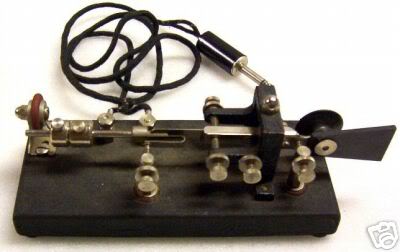
Saturday, March 4, 2017
Among the top sources for information on collectible keys is Tom French’s (SK) newsletter, The Vail Correspondent, a quarterly key collector’s newsletter, from October 1992 through July 1998. Its available now in PDF form on a CD, but my copies are on paper. While the articles are dated, there’s lots of excellent information written by some of the top folks in the key collecting universe of the mid-to-late 1990s.
After receiving my recent Cedar Rapids bug in the mail, I recalled that the Vail Correspondent had a Cedar Rapids bug on the cover of one issue, as well as lots of additional history on the key. There’s some real nuggets of factual information there that deserves to be shared with our collecting community (for those — like me — who don’t remember these things, hi!).
For starters, the Cedar Rapids bug was offered in two variations — the radio key and the landline key. The radio key was aimed at the ham market, and it was THIS version of the key that was offered in kit form.
 The other key — the “professional” key — was marketed to the landline telepgraph community. This key was sold only as an assembled product. It is safe to assume that telegraphers who worked the landlines for a living wanted to buy a key they could put to work immediately without tinkering around with building the thing.
The other key — the “professional” key — was marketed to the landline telepgraph community. This key was sold only as an assembled product. It is safe to assume that telegraphers who worked the landlines for a living wanted to buy a key they could put to work immediately without tinkering around with building the thing.
The earliest ads for the kit version of the key are in 1936 QST magazine. A listing in the “HAM Ads” section — QST’s version of classified ads — stated the kits for the radio key were available for $2.98.
The article in Vail Correspondent No. 21 notes that there were several different versions of the key built during its run. For example, there were two different cast bases for the key (one had a boss for a “fifth” foot so you could make it have four or three feet; two styles of damper support (one cast, the other plated stamped sheet metal), and two styles of underside wiring (one version used hook up wire, the second used stamped brass stock).
Some other differences include the circuit closer; the earliest keys had a 3-inch long circuit closer on the right side on the key; later keys used a right-angle circuit closer lever.
Over the course of their production, the earlier keys had pivot frames of cast brass; later (as indicated on sales information) the frames were painted aluminum.
According to Doug Seneker, N0WAN’s article in the Vail Correspondent, the telegraph keys were called the “CR telegraph speed key” while the key lacking a circuit closer were called the “CR Radio speed key.” The telegraph key was sold assembled, while the radio key was the one sold as a kit. The radio key was also offered assembled.
A flyer from the 1940s from Electric Specialty Mfg. Co. also offers a steel case for the CR keys — a bargain at $4 postpaid.
The prices were competitive with the other manufacturers. For example:
$13.98 – Telegraph key assembled, complete with wedge cord and carrying case.
$9.98 – Same as above without the carrying case.
$8.98 – Telegraph key without wedge cord.
$7.98 – Radio key assembled.
$5.98 – Radio key kit
$1 – Wedge cord
$4 – steel case
Buyers had 10 days to return the items if they were unsatisfied and receive a full refund.
GET YOURS! With the untimely passing of Tom French, there’s just one source to get your own copies of the Vail Correspondent — the Morse Express website. You can get all 24 copies of the quarterly newsletter on a CD-ROM for $15. Its worth the money, trust me. You can also get Tom French’s books that have been out of print for years but valuable sources for collectors — “McElroy, World’s Champion Radio Telegrapher,” and “The Vibroplex Collector’s Guide.”
Get yours today at Morse Express on the books page!
73 es CUL …. de KY4Z SK … dit dit ….
